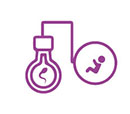FERTILITY ASSESSMENT – STEP BY STEP
Very often we get to see women walking alone into the clinic of a Fertility specialist to get herself checked as she is unable to conceive after many years of marriage. In 40% cases of infertility, it is the female factor, and for another 40% it is the male factor and 15% cases are due to combination of both male & female factors and for the remaining 5% the cause is unexplainable.
When to get a Fertility Assessment?
- If you are trying to get pregnant and have been trying for more than 12 months.
- If you are over 35 years, since with AGE reproductive capacity goes down especially for women, you should seek early assessment may be with six months of marriage.
- History of recurrent miscarriage
- PCOS
What is included in Fertility Assessment?
- Male fertility assessment
- Semen Analysis
- Female fertility assessment
- Anti-Mullerian Hormone(AMH) Test
- Body Mass Index Assessment
- Ultrasound on Day 2 of period
- Hysterosalpingogram or HSG
- Hysteroscopy/Laparoscopy
- Review with Fertility Specialist
Semen Analysis :- It measures the quantity and quality of a man’s semen and sperm – assessing characteristics such as sperm count, motility (movement) and shape.
According to WHO, male factor infertility is an alteration in one or more of the following parameters in one of the two samples collected 4 weeks apart:
- Sperm count – 15 million/ ml of semen
- Motility – 40% sperms should be motile
- Morphology (shape) – 4% normal forms
Sperm cryopreservation (freezing) is recommended to preserve fertility in men staying away from their family or undergoing cancer therapy.
Anti-Mullerian Hormone (AMH) :- Levels are assessed by a simple blood test that can be done on any day of the cycle and helps to know the capacity of a woman to produce eggs at any given point of time. The lesser the no of eggs in the ovary, lower will be the AMH level.
Woman with diminished ovarian reserves is at a risk of fertility problems and an increased risk of miscarriages.
| AMH Levels | Interpretation |
|---|---|
| Less than 1.0 ng/ml | Low ovarian reserves |
| 1.0 -3.0 ng/ml | Normal |
| More than 3.0ng/ml | PCOS |
Body Mass Index Assessment:- Being overweight or underweight impacts fertility in both men and women thereby reducing the chances of pregnancy. Maintaining BMI between 18.5 to 24.9 is ideal for conception and increases the chance of a healthy pregnancy and baby.
Ultrasound on Day 2 of period:- A transvaginal ultrasound is done on day 2 of periods to count the number of antral follicles. An ultrasound also helps rule out any anatomical abnormality.
Hysterosalpingogram or HSG:- In young patients (less than 30 years) with good ovarian reserve and with normal semen analysis report of husband, HSG is advised to see whether the tubes are open. It is an X-ray test done by the fertility specialist by injecting a harmless dye into the womb, which should flow into the fallopian tubes. The dye is visible on an X-ray showing whether the tubes are open or blocked. And if the tubes are blocked or any filling defect seen on X-Ray, the next step would be laparoscopy along with hysteroscopy.
A laparoscopy/hysteroscopy is the gold standard to assess the uterine cavity, tube-ovarian relationship and patency of the fallopian tubes
Review with a Fertility Specialist:- Once all the investigations are done, your fertility specialist will explain the fertility potential. In case, all your reports are normal, the fertility specialist might recommend further investigations.
A fertility assessment gives us a clear picture of the reproductive ability of the couple along with reassuring them that medical technology can help them become parents if there are any factors causing infertility.

